by Eddie Powell | Aug 12, 2013
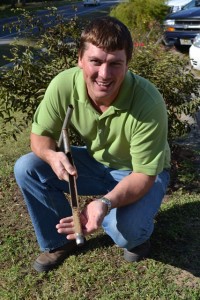
Soil Sampling Probe
Image Credit: Eddie Powell
Often, vegetable gardeners that I work with through the Walton County Extension office pose the question: Why should I take a soil sample?
I always answer that soil testing will determine whether lime and fertilizer need to be applied to the soil to support good plant growth.
Soil sampling must be done prior to the planting of crops so that it can be determined whether or not adequate levels of nutrients are present in the soil and if the pH is at the proper level for the type of crop grown. The test results of these soil samples will also indicate the amount of fertilizer that should be applied to the garden.
Keep in mind that this test only tells you the amount of fertilizer (if any) to add to the soil, and does not specify when and how often it should be applied. Such information can be gathered at your local Extension Office.
It is best to consult with your local extension agent once you have received your soil results so that he or she can advise you on the proper steps to take as to when and how to apply fertilizer and/or lime to the soil. Also, refer to this publication for tips on soil testing for the home vegetable garden.
Soil testing will save money in the long run and is the most important step that is taken in preparing garden soils for good plant growth. Remember, the fall growing season is the time to do your soil testing for the spring. Contact your Local UF/IFAS Extension Office for a soil test kit.
by Taylor Vandiver | Aug 12, 2013
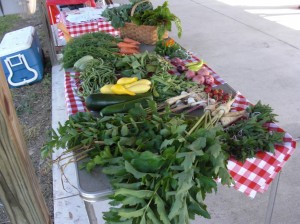
Consumers worldwide are rediscovering the benefits of buying locally grown food. However, this notion is not necessarily new. Farmers have been making their freshly produced wares available at local locations for years.
So, why should anyone buy local? Local produce is considered fresher, tastier, and more nutritious. Studies have shown that fresh produce loses nutrients quickly during transportation. During the trip from harvest to dinner table, sugars in the plants turn to starches, plant cells shrink, and produce loses its vitality. Food grown in the local community was probably picked within the past day or two and, therefore, is much fresher. It is also good for the local economy.
Buying directly from family farms helps them stay in business. Less than 1% of Americans now claim farming as their primary occupation, which isn’t surprising considering that today’s farmer gets less than 10 cents of the retail food dollar. Local farmers who sell directly to consumers get full retail price for their produce. Buying local decreases the likelihood of urbanization and increases the diversity of produce available locally.
As the value of direct-marketed fruits and vegetables increases, selling farmland for development becomes less likely. Also, rural farming areas can serve as a habitat for many species of wildlife. Buying local produce proactively preserves the agricultural landscape. By supporting local farmers today, you can help ensure that there will be farms in your community tomorrow, that there will be a habitat for wildlife, and that future generations will have access to locally produced food.
How can you be involved in this resurging concept, you might ask? One of the many ways you can provide support, while gaining fresh produce, is to join a CSA. The term CSA stands for Community Supported Agriculture. It involves one or more farmers, and many individuals or families, from a community who pledge financial support to a farm operation. The farmers and consumers share the risks and benefits of food production. Members are considered “share-holders” of the farm and they generally pledge in advance to cover the anticipated costs of the farm operation and farmer’s salary.
In return for their commitment, consumers receive “shares” or a regular portion of what has been harvested from the farm throughout the different growing seasons. There are risks associated with farming that affect both the farmer and the shareholder, including poor harvests due to unfavorable weather or pests. By selling directly to their community farmers receive better prices for their crops, gain some financial security, and are relieved of much of the burden of marketing. Members benefit because they receive a wide variety of fresh, local produce harvested at the peak of freshness and flavor. If you would like to find a CSA in your community you can visit the local harvest website.
There are numerous other opportunities to be involved in supporting local agricultural operations. A good place to start would be to make a visit to your local Extension office. The agents there can help point you in the right direction, whether you want to start your own farming operation or simply provide fresh produce for your home.
by Beth Bolles | Aug 5, 2013
Thinking of bulbs for the garden? Summer is not necessarily the time of year that gardeners think about beautiful blooms from bulbs and bulb-like plants, but there are many that bloom in the summer garden.
In general, many types of plants with an underground storage organ are classified as a bulb. These include plants with tubers, rhizomes, or corms. True bulbs including Lycoris and Crinum lily are compressed stems with a growing point surrounded by thick, fleshy scales. Corms such as Crocosmia are solid masses of stem tissue with a terminal bud and side nodes. The rhizome is an underground stem that grows laterally, with representatives of this type being blackberry lily and ginger.
It is likely that your garden is full of bulb-like plants and you were just not aware of their underground beginnings. If you want to consider a few more for the summer garden, here are some good choices.
Blackberry lily is a member of the Iris family that offers good summer bloom in our northern Florida gardens. Plants form sprays of foliage about 2 feet in height with stalks of orange flowers with red spots. Plant in full sun or partial shade and supply with well drained, amended soil.
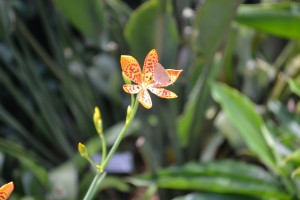
A hairstreak butterfly visits the Blackberry lily flower.
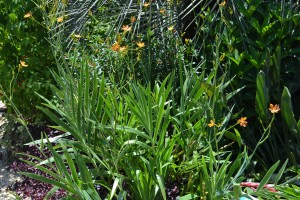
Another bright summertime bloomer is Croscomia. Commonly overlooked early in the year as foliage regrows from the cold, the bright orange flowers that emerge in summer make it a feature in garden beds. Plants grow well in both full sun and partial shade but clumps can expand easily beyond the desirable planting area. Thin out every few seasons to keep the clump manageable.
A tuberous perennial that will have stunning flowers closer to eye level is the Gloriosa or flame lily. Plant stems will wind around a trellis or garden feature, hold on with tendrils, and support large upward-curved petals. Flower colors are red, yellow, orange, or mixes of several colors. Flame lily prefers sunny locations and lots of moisture in the growing season. Winter soils should be drier to prevent tubers from rotting.
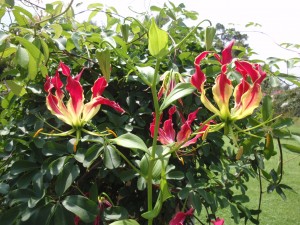
Flame lily growing with a spring blooming vine.
All of these options can enhance your garden and extend your bulb growing season beyond the spring. Happy Gardening!
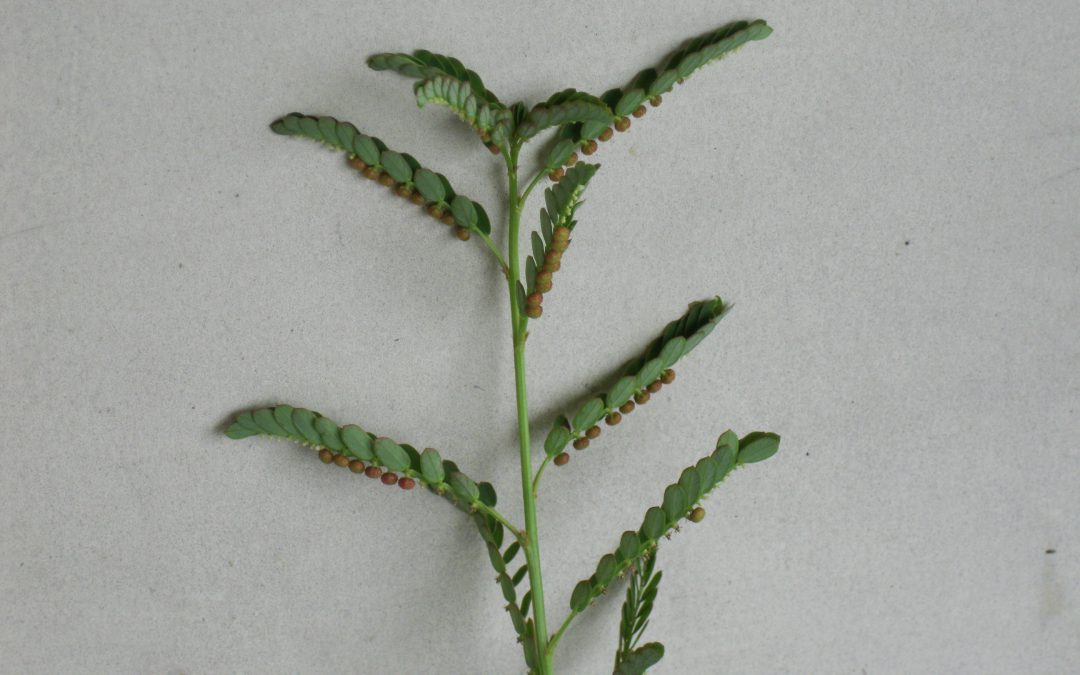
by Julie McConnell | Aug 5, 2013
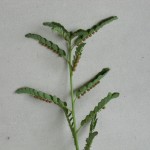
Chamberbitter
Above average rainfall this summer has supplied water to more than just our landscapes, weeds are benefiting and flourishing as well.
Just as with any other landscape pest, proper weed control starts with accurate identification and knowledge about the life cycle of the weed.
When weeds are low in number, mechanical control (pulling, mowing) is a good start. If weed population continues to increase and herbicide options are considered, several questions need to be answered before product application.
Questions you need to ask yourself about your weed and site:
- What weed(s) are you trying to control?
o Be sure you know what the name of the weed is so that you can find it on your product label “weeds controlled” list; if you need help with identification contact your local county extension office
- What is your site?
o Lawn – specific turfgrass is important, what is safe to use on one type may kill another
o Ornamental beds – again note specific plants near your treatment area in case of sensitivity
o Water bodies – some herbicides are not labeled for use within a given distance of water; if the weed is in or around the water only use herbicides listed for aquatic weed control
- What is the life cycle of your weed?
o Annual – one season life cycle, summer annuals complete their life cycle between spring and fall; winter annuals are active between fall and spring
o Biennial – two growing season life cycle
o Perennial – plant lives for three or more years
- What category does your weed fall into?
o Grasses – one seed leaf as it emerges from the soil; hollow, rounded, stems with nodes, parallel veins in true leaves; examples are crabgrass, dallisgrass, cogongrass, torpedograss
o Broadleaves – have two seed leaves and true leaves have net-like veins and usually have showy flowers; examples are lespedeza, dollarweed, clover, chickweed, henbit, florida betony
o Sedges/Rushes – sedges have solid triangular stems; rushes have round stems; both like moist or wet habitat; examples are purple nutsedge, yellow nutsedge, beak rush
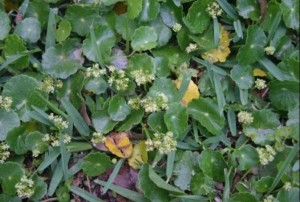
Dollarweed: Image Credit Edis ENH1128
Basic information about herbicide categories:
For more information read EDIS Publication “Weed Management in Home Lawns”
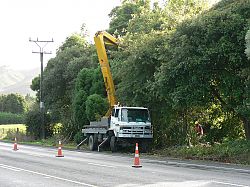
by Sheila Dunning | Jul 29, 2013
 With hurricane season upon us, evidence of preparation is all around us.
With hurricane season upon us, evidence of preparation is all around us.
Tree trimmers, contracted by the local electrical utility companies, have been removing trees, branches and other vegetation that is “too close” to power lines. Many homeowners are concerned over the practice.
In order to prevent power outages, the federally approved Vegetation Management Reliability Standard, FAC-033-2, requires utilities to manage vegetation growth along the path of power lines to prevent contact. A minimum clearance of fourteen (14) feet between trees and transmission lines in the right-of-way must be maintained at all times in order to achieve service reliability and public safety.
By Florida Statute 163, an electric utility is granted easement or right-of-way on private property in order to build and maintain electric power lines. Vegetation maintenance allows for the mowing of vegetation within the right-of-way, removal of trees or brush within the right-of-way and selective removal of tree branches that extend within the right-of-way by the electric utility personnel, licensed contractors or International Society of Arboriculture (ISA) Certified Arborists. The choice of how to trim trees and manage vegetation growth near a power line (e.g. pruning, herbicides, or tree removal) is primarily made by the electric utility, subject to state and local requirements and laws, applicable safety codes, and any limitations or obligations specified in right-of-way agreements. An individual may contact the utility company to obtain a copy of the right-of-way agreement for their property.
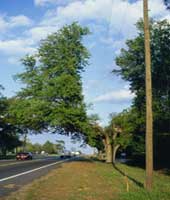 Sometimes, it appears to some that excessive vegetation has been removed. But, remember the utility companies are required to maintain the appropriate clearance “at all times.” For example, in the summer, power lines sag as they expand from rising air temperatures and heavy use. Also, wind and future growth must be taken into account when determining where to prune. Electric utilities usually prune or remove vegetation to a distance greater than the minimum clearances to account for all these factors.
Sometimes, it appears to some that excessive vegetation has been removed. But, remember the utility companies are required to maintain the appropriate clearance “at all times.” For example, in the summer, power lines sag as they expand from rising air temperatures and heavy use. Also, wind and future growth must be taken into account when determining where to prune. Electric utilities usually prune or remove vegetation to a distance greater than the minimum clearances to account for all these factors.
Tree trimming around power lines may seem like a local issue, but vegetation growth also affects interstate transmission lines. The U.S. Department of Energy estimates that electric utility service interruptions cost businesses and communities tens of billions of dollars annually. Tree contact with transmission lines was the leading cause of the August 2003 blackout that affected 50 million people in the Northeastern United States and Canada. In fact, that particular blackout prompted Congress to pass the Energy Policy Act of 2005, which lead the Federal Energy Regulatory Commission (FERC) to establish the Vegetation Management Reliability Standard.
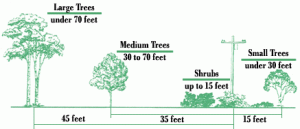 Should we have a storm that impacts Northwest Florida, remember that the clearing of trees and branches provides faster access for first responders, line repair crews, and other emergency service personnel. So, as you watch the preparation work being done, think about where you will be planting a tree so that it can reach full maturity without threatening power lines, therefore, not requiring “ugly pruning!”
Should we have a storm that impacts Northwest Florida, remember that the clearing of trees and branches provides faster access for first responders, line repair crews, and other emergency service personnel. So, as you watch the preparation work being done, think about where you will be planting a tree so that it can reach full maturity without threatening power lines, therefore, not requiring “ugly pruning!”
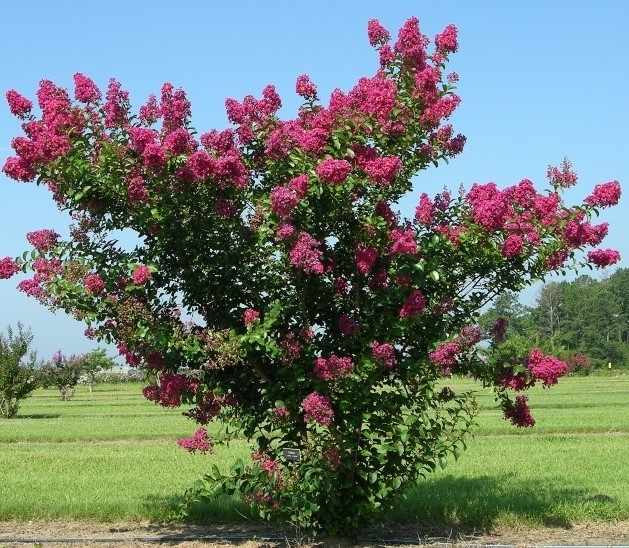
by Gary Knox | Jul 29, 2013
Crapemyrtle flowering has been spectacular this year!
While most other garden plants droop from summer’s heat, humidity and heavy rains, crapemyrtle thrives and puts on an outstanding show of flowers all summer and fall. Thanks to modern breeders, there are all sizes of improved hybrid crapemyrtles with flower colors of lavender, purple, white, pink, or red.
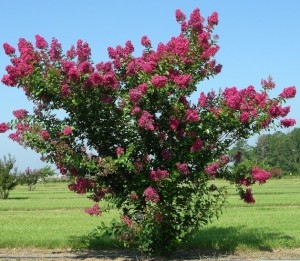
Crapemyrtle Cultivar: ‘Tonto’
Image Credit: Gary Knox
Just say “No” to Pruning
- Crapemyrtle varieties come in tree-size, patio tree and shrub categories.
-
Tree-size crapemyrtles grow 25 ft. tall and are ideal as flowering trees. Patio tree-form plants (up to 12 ft.) are beautiful as small, flowering specimen plants near patios, walkways, and entrances. Shrub forms (up to 6 ft.) make excellent accents in a shrub border and smaller types are effective as large groundcovers or container plants.
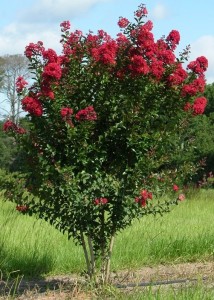
Crapemyrtle Cultivar: ‘Red Rocket’
Image Credit: Gary Knox
- Make sure you buy the right size crapemyrtle for your home. Don’t make the mistake of planting a tree-size crapemyrtle in an area too small for its ultimate size, or you’ll find yourself pruning it hard – and often – to keep it from out-growing its place.
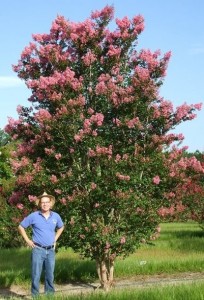
Crapemyrtle Cultivar: ‘Sioux’
Image Credit: Gary Knox
Recommended Varieties
- Some of the best tree-size (25 ft.) types are Natchez (white), Red Rocket® (red), Sioux (pink) and Apalachee (lavender). Superior patio tree crapemyrtles (12 ft.) are Acoma (white), Cheyenne (true red), Tonto (fuchsia red), Hopi (pink) and Catawba (purple). Smaller shrub (6 ft.) crapemyrtles are hard to find, but Cherry Dazzle® is a nice mounding red and Pixie White and New Orleans (purple) are good selections.
Planting and Garden Care
- When it comes to planting, crapemyrtle is very tolerant and forgiving with three exceptions. First, crapemyrtle needs sun to flower freely, so plant it in a site receiving at least six hours of direct sunlight each day. Secondly, crapemyrtle will not grow in wet soils. Finally, never plant crapemyrtle too deep — if you do so, it will punish you by not flowering for years and years. Planting too deep literally smothers the roots, requiring the crapemyrtle to regenerate a new root system in the soil above.
- Crapemyrtle is very drought tolerant and almost seems to thrive on neglect. On the other hand, regular watering and fertilizer will help crapemyrtle grow faster and bigger.
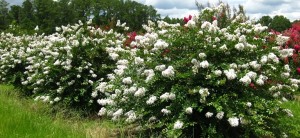
Crapemyrtle Cultivar: ‘Acoma’
Image Credit: Gary Knox
More Beauty on the Way!
- Breeders are continuing to improve and introduce new crapemyrtles. Many new varieties were released in the last couple years. In particular, watch for new types with purple-burgundy leaf color all summer long! Time will tell which new ones grow best in Northwest Florida. Stay tuned as the world of crapemyrtle continues to evolve and improve!
*Gary Knox is Professor of Environmental Horticulture with the University of Florida. He is stationed at the North Florida Research and Education Center in Quincy, where he evaluates more than 100 cultivars of crapemyrtle.
















